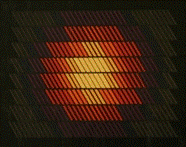



|
NAME |
VideoBrain |
|
MANUFACTURER |
Umtech Inc. |
|
TYPE |
Home Computer |
|
ORIGIN |
U.S.A. |
|
YEAR |
1977 |
|
END OF PRODUCTION |
Unknown |
|
KEYBOARD |
Full stroke 36 keys. |
|
CPU |
Fairchild F8 |
|
SPEED |
2.0 MHz |
|
COPROCESSOR |
None |
|
RAM |
1 KB |
|
ROM |
4 kB |
|
BUILT IN LANGUAGE |
APL/S |
|
TEXT MODES |
16 x 7 matrix |
|
GRAPHIC MODES |
Several built-in graphics characters |
|
COLORS |
16 |
|
SOUND |
None |
|
I/O PORTS |
HF TV output. Joystick, cassette, modem and printer |
|
SIZE / WEIGHT |
|
|
POWER SUPPLY |
External power supply. |
|
PRICE |
$299 |
|
VideBrain
|
|
The VideoBrain was an obscure and ultimately short-lived system, yet it holds a special place in computer history
as the first cartridge based computer system.
|